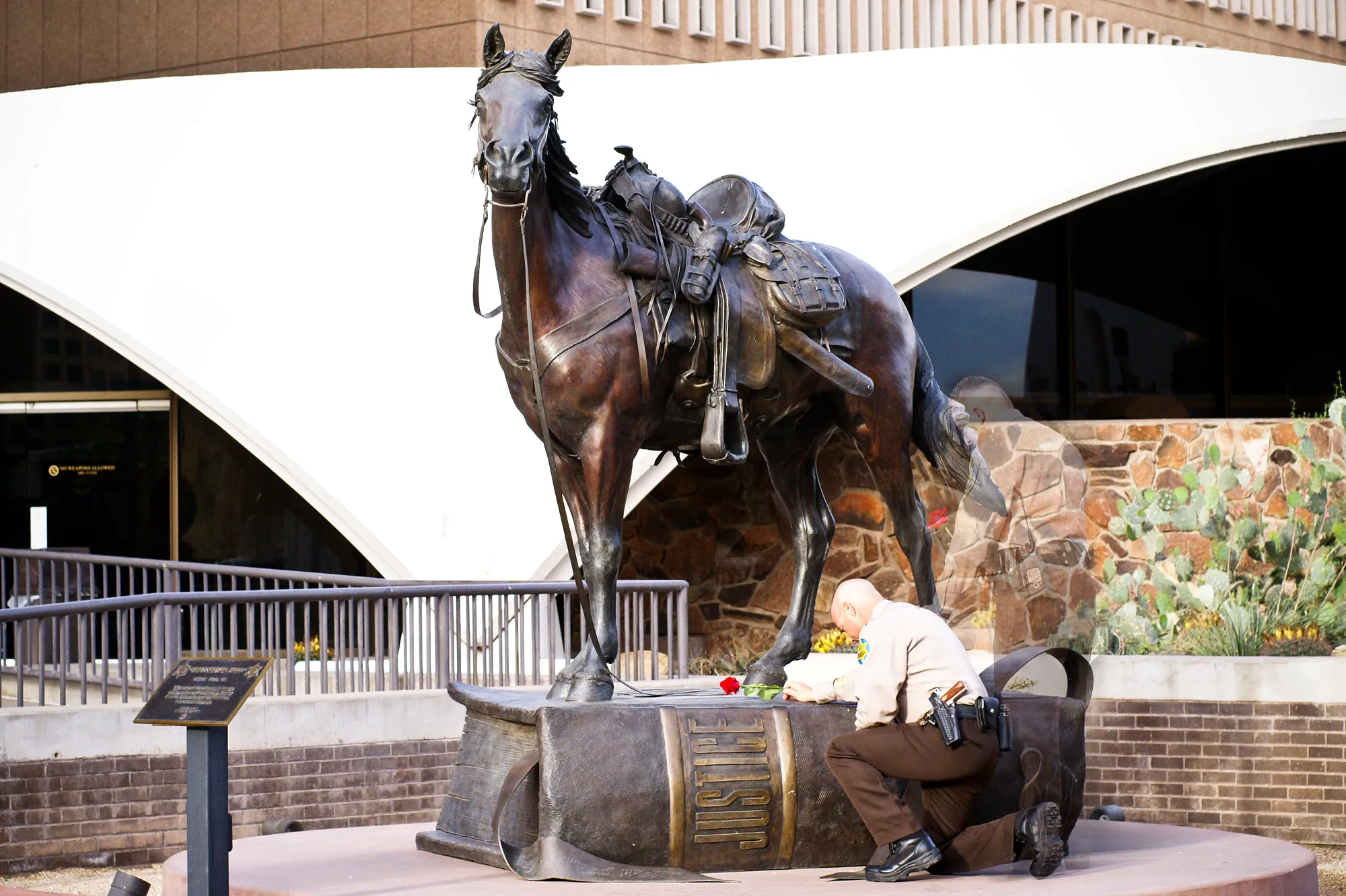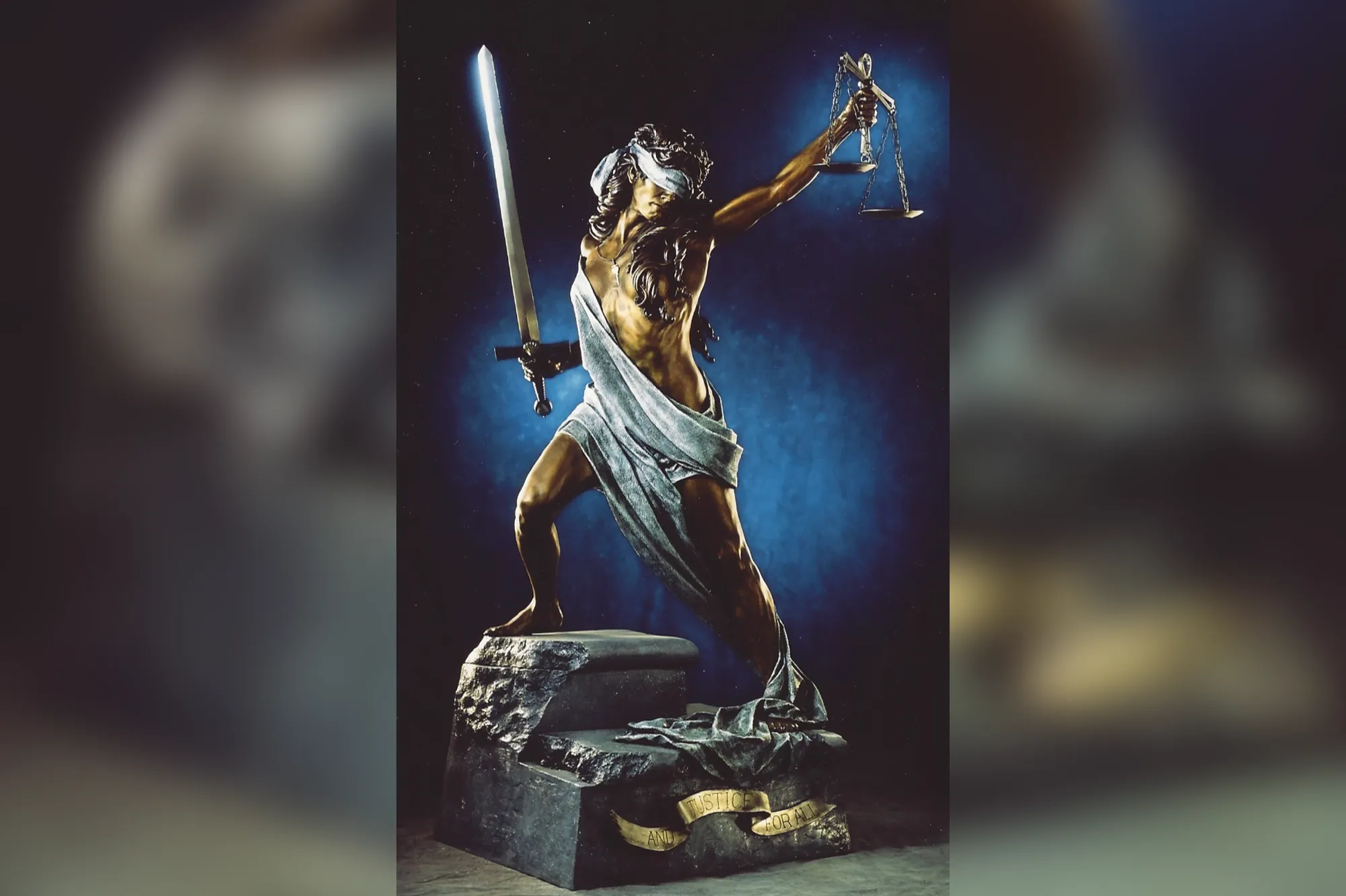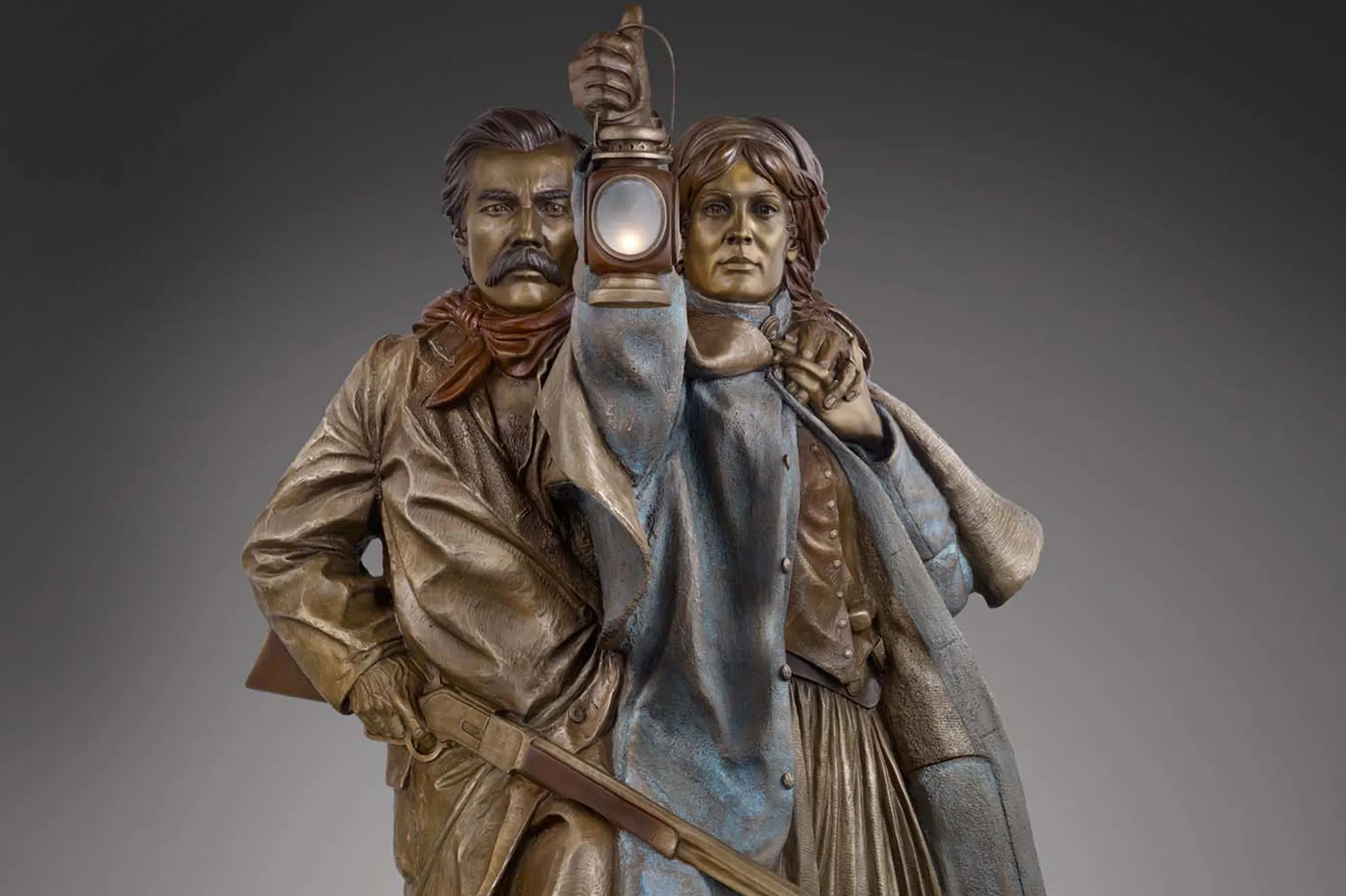The Artistic Journey of James Muir: Master of Allegory and History in Bronze
COVER STORY OCTOBER 2024 (Cover Photo by Mike Thompson)
https://magazine.discovertheregion.com/flip-book/305679/1521110/page/76
BY RICK ROME
James Muir stands out as one of the preeminent American sculptors of our time, he is a visionary artist whose work far transcends the conventional boundaries of bronze sculpture.
His creations are highly celebrated not only for their craftsmanship but also for the deep allegorical significance that each embodies. Muir’s sculptures offer a deeply profound commentary on history, spirituality, as well as the human condition, using symbolism and form to explore universal themes of morality, justice, and freedom.
This issue of Discover The Phoenix Region delves into the life and artistic journey of James Muir and examines some of his most iconic works.
Early Life & Military Influence
James Muir was born with an innate passion for both art and history. Raised in a family with a deep appreciation for American history, Muir developed a strong connection to the stories of the past, particularly those of the American frontier and the nation’s military. This connection was further strengthened when he joined the military himself through an appointment to West Point, an experience that would later have a profound influence on his work.
Muir’s time spent in the military introduced him to the concepts of duty, honor, sacrifice, and the very stark realities of war. His experiences served as a bedrock for his future artistic endeavors, shaping his approach to portraying historical and military subjects. While Muir’s sculptures would eventually span a wide array of themes, his military background lent authenticity and emotional depth to his depictions of soldiers and of battle scenes, establishing him as a powerful voice in American art.
The Transition to Sculpture
While Muir’s artistic talents were evident from a young age, it wasn’t until later in life that he discovered his true calling as a sculptor. His fascination with bronze as a medium arose from its ability to capture intricate detail as well as convey permanence. Muir honed his craft over time, mastering the complex techniques required to work with bronze. His sculptures, which are characterized by their precision and attention to detail, soon began to garner attention from galleries and collectors alike.
However, it was not just Muir’s technical skills that set him apart—it was his ability to imbue his sculptures with layers of meaning. Each of Muir’s works tells a story, often inviting viewers to look beyond the surface and consider the deeper allegorical messages contained within. Muir’s use of symbolism allows his sculptures to resonate on multiple levels, appealing not only to art enthusiasts but also to those with an interest in philosophy, history, and spirituality.
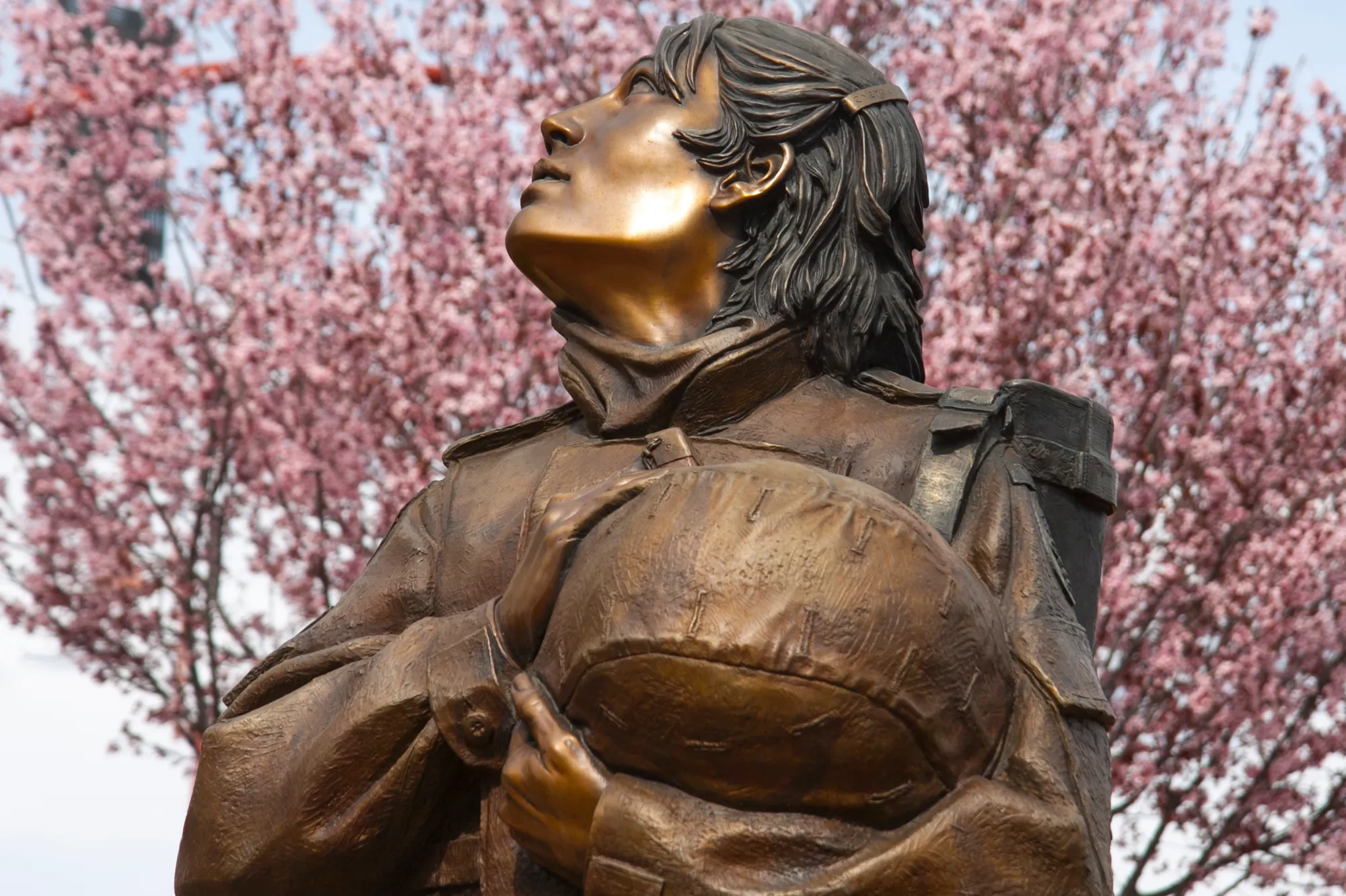
Muir’s Athena’s Prayer depicts a modern-day Athena, the goddess of War and Wisdom, standing in quiet reflection after returning from battle, her helmet held protectively over her heart as she gazes upward in prayer, inviting the viewer to contemplate the healing and personal toll of war. This bronze sculpture serves as a tribute to the courage and sacrifice of all women who have served in America’s Armed Forces. Photo by Peter Galea
Allegory in Bronze:
One of the defining characteristics of James Muir’s work is his use of allegory. His sculptures often explore themes of morality, justice, freedom, as well as human interconnectedness. Muir uses symbolism and metaphor to express his ideas, offering viewers a chance to reflect on the universal truths that underpin the vast human experience.
”They Served Well”
James Muir’s “They Served Well” is a powerful tribute to the peace officers of the Maricopa County Sheriff’s Office (MCSO) who sacrificed their lives in service. This sculpture serves as a memorial to those who have fallen in the line of duty, standing as a symbol of dedication and bravery. Each element of the sculpture carries deep symbolic meaning, making it more than just a memorial—it is an embodiment of the values of law enforcement and an inspiration for future generations of officers.
At the heart of the sculpture is a Spanish Colonial horse, representing the Sheriff’s Office. This horse, a strong and vigilant figure, stands with its feet planted on the Book of Justice, symbolizing a connection to the higher ideals of truth and righteousness. The horse stands firm against the winds of adversity, reflecting the department’s unwavering commitment to protecting and serving the community, even in the face of great challenges.
One of the most poignant features is the empty saddle, a silent reminder of the fallen officer. This 1910-1920 H.H. Heiser saddle was popular among Arizona Sheriffs and Rangers and is adorned with hearts on the breast collar to honor those who made the ultimate sacrifice. The pistol belt and Badge of Honor draped over the saddle horn symbolize the legacy of the officer and the readiness of the next individual willing to take up the mantle of service.
The rifle and lariat hanging by the saddle represent the tools of the trade, but they also symbolize law enforcement’s long reach across all 50 states. The Model 94 Winchester rifle and 50 feet of lariat illustrate the forceful yet peaceful means by which officers carry out their duties. The Model 1873 Colt .45 Single Action pistol, with its 12 cartridges, represents the twelve months a year officers are on duty, while the 24 rifle cartridges signify the around-the-clock nature of their service. This dual symbolism of time and vigilance highlights the commitment peace officers have to their community.
The saddlebags and canteen, modeled after U.S. cavalry surplus items, represent the safety, welfare, and sustenance officers provide to the people they serve. The bit used by the horse, also a cavalry surplus model, underscores the very unique relationship between the Sheriff and the community. The Sheriff is directly accountable to the people, and this responsibility is symbolized by the bit, representing the Sheriff’s role as a “Peace Officer” who serves at the will of the voters.
Perhaps the most meaningful part of the sculpture is the Badge of Honor. Modeled after a badge from 1922, it bears the number “15,” which represents the fifteen deputies who had lost their lives in service at the time of the sculpture’s dedication in 2001. This badge ensures that the fallen officers are forever remembered by the community and their peers.
Standing on the Book of Justice, the horse also symbolizes eternal justice, with the eternity symbol on the book highlighting the timeless nature of law enforcement’s mission. The circular red platform on which the horse stands represents the blood shed by the fifteen deputies who gave their lives in service, a tribute to their ultimate sacrifice to protect and serve.
Finally, the 13th Bullet, also known as the Eternal Enigma, serves as a reminder of the unknown risks and uncertainties peace officers face daily. This bullet represents the very unpredictable nature of their work and the dangers inherent in their duty.
James Muir’s “They Served Well” is more than a memorial—it is a powerful testament to the courage and sacrifice of peace officers, while capturing the essence of duty, service, and honor. Through its intricate symbolism, the sculpture stands as an enduring reminder of the values that guide law enforcement and the sacrifices made to uphold justice. It serves as both a tribute to those who have fallen and as an inspiration for future officers to continue the mission of protecting and serving with integrity.
“…and Justice for All”
Another iconic piece is “… and Justice for All”, a sculpture that embodies the ideals of fairness and equality. In this work, Muir depicts a blindfolded figure holding a sword and scales, which is a classical representation of Lady Justice. However, Muir’s interpretation of this age-old symbol is both modern and timeless. The sword represents the power of truth, while the scales symbolize the careful balance of justice.
In “..and Justice for All,” Muir challenges viewers to reflect on the state of justice in our modern society. The blindfold over the figure’s eyes, traditionally meant to represent impartiality, takes on new meaning in Muir’s work. He prompts us to question whether true justice is always blind or if it is sometimes influenced by external forces. The intricate detailing of the figure’s robes and the polished finish of the bronze further elevate this piece, making it one of Muir’s most profound and enduring works.
“Christ of the Holy Cross”
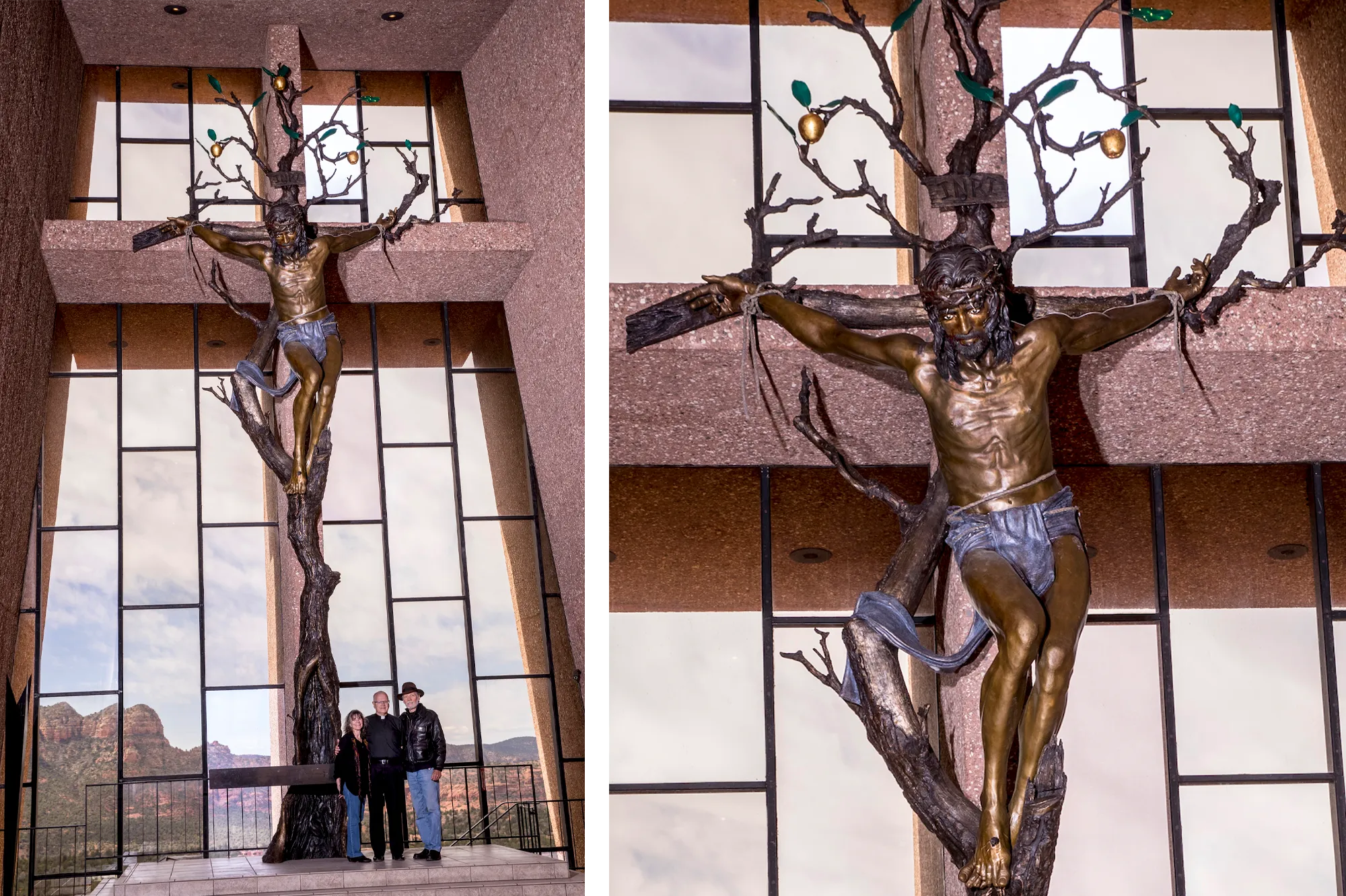
“Christ of the Holy Cross” at the Chapel of the Holy Cross in Sedona Arizona. Photo by Alex Stricker
Muir’s deep spiritual sensitivity is exemplified in his work “Christ of the Holy Cross”, a sculpture that embodies the profound sacrifice and the
unconditional love that is symbolized by Christ’s crucifixion. This masterpiece stands prominently at the Chapel of the Holy Cross in Sedona, Arizona, inviting reflection and reverence from all who visit. The sculpture, installed in 2018, portrays Christ on the cross, with striking realism and emotional depth, capturing the moment of the ultimate sacrifice for humanity’s salvation.
The crucifixion scene is more than a mere depiction of suffering; Muir’s sculpture conveys a message of the redemption, grace, and the triumph of love over death. Every element, from the detailed anatomy of Christ’s figure to the texture of the cross itself, is crafted to evoke both the physical torment and the spiritual transcendence of the moment. The piece resonates with viewers regardless of their religious background, as it speaks to the universal themes of sacrifice, forgiveness, and divine love.
Much like Muir’s other works, “Christ of the Holy Cross” transcends its religious subject matter to communicate deeper, universal truths. The sculpture stands as a powerful representation of faith, hope, and the eternal promise of salvation.
Historical Sculptures: Preserving the Past
In addition to his allegorical works,
James Muir has created a significant body of historical sculptures. These pieces, often depicting figures from the American West
& key moments in military history, serve as a visual chronicle of the
nation’s past. Muir’s ability to capture historical detail and bring it to life in bronze has earned him a reputation as a master of historical sculpture.
“Lighted Lantern”
Muir’s “The Lighted Lantern” is a striking life-sized sculpture standing 6 ½ feet tall with a 5-foot diameter, embodying the strength, hope, and unity of the pioneer spirit. The sculpture depicts
a pioneer couple holding aloft the
Lantern of Hope, symbolizing their
courage to face the unknown and their commitment to a future of freedom for all. Their bond, illuminated by the lantern’s light, represents a union grounded in trust and determination. The couple’s journey is marked by the broken wagon wheel beneath them, a poignant reminder of the end of one chapter and the start of another as they venture into new, uncharted territories.
The man, armed with a Model 1876 Winchester, stands firmly on the Book of Truth, a testament to their pursuit of honesty, integrity, and justice. Every element of The
Lighted Lantern speaks to the
enduring resilience of pioneers.
“Duty First”
Muir’s bronze sculpture “Duty First” stands as a powerful tribute to the gallant men of the U.S. 26th Cavalry Philippine Scouts. The 15-foot statue depicts a Filipino cavalryman on horseback, which symbolizes the bravery, dedication, & service of these soldiers during war. The detail in the figure, both the rider and his horse—reflects Muir’s commitment to historical accuracy, while the dynamic pose of the cavalryman conveys the readiness and resolve that defined the Philippine Scouts in their fight for freedom. The title, Duty First, underscores the Scouts’ unwavering commitment to their mission, even in the face of overwhelming odds.
Unveiled in Chicago, Illinois, in 2010, Duty First stands as a lasting tribute to the legacy of the Philippine Scouts. Muir’s ability to capture not just the physical form but the spirit of this soldier, elevates the sculpture well beyond mere representation; it becomes a testament to sacrifice and valor. The statue serves as a reminder of a lesser-known chapter in military history, honoring those who fought bravely and ensuring that their story continues to inspire future generations.
A Legacy of Art & Meaning
James Muir’s contributions to the world of sculpture extend far beyond his technical mastery of bronze. His works, whether allegorical or historical, engage viewers on a deeply emotional and intellectual level. By blending symbolism, historical accuracy, and philosophical reflection, Muir has created a body of work that speaks to the universal human experience. His sculptures challenge us to think critically about issues of justice, freedom, and morality, while also reminding us of the importance of remembering and honoring the past.
Muir’s legacy as an artist is one of profound meaning and lasting impact. His sculptures have found homes in museums, galleries, and public spaces across the United States, where they continue to inspire and provoke thought. For those who encounter his work, James Muir offers not only an appreciation of beauty and craftsmanship but also an invitation to engage with the deeper questions that shape our world.
In an era when art is often fleeting, James Muir’s sculptures stand as enduring symbols of the values and ideals that define us as human beings. Whether through his depictions of historical figures, allegorical representations of justice and freedom, or his tributes to the military, Muir has crafted a timeless and powerful body of work that will resonate for the generations to come.
You can learn more about James Muir by visiting https://www.jamesmuir.com

 Mike Thompson (Raw) & Discover The Phoenix Region Magazine (Cover)
Mike Thompson (Raw) & Discover The Phoenix Region Magazine (Cover)